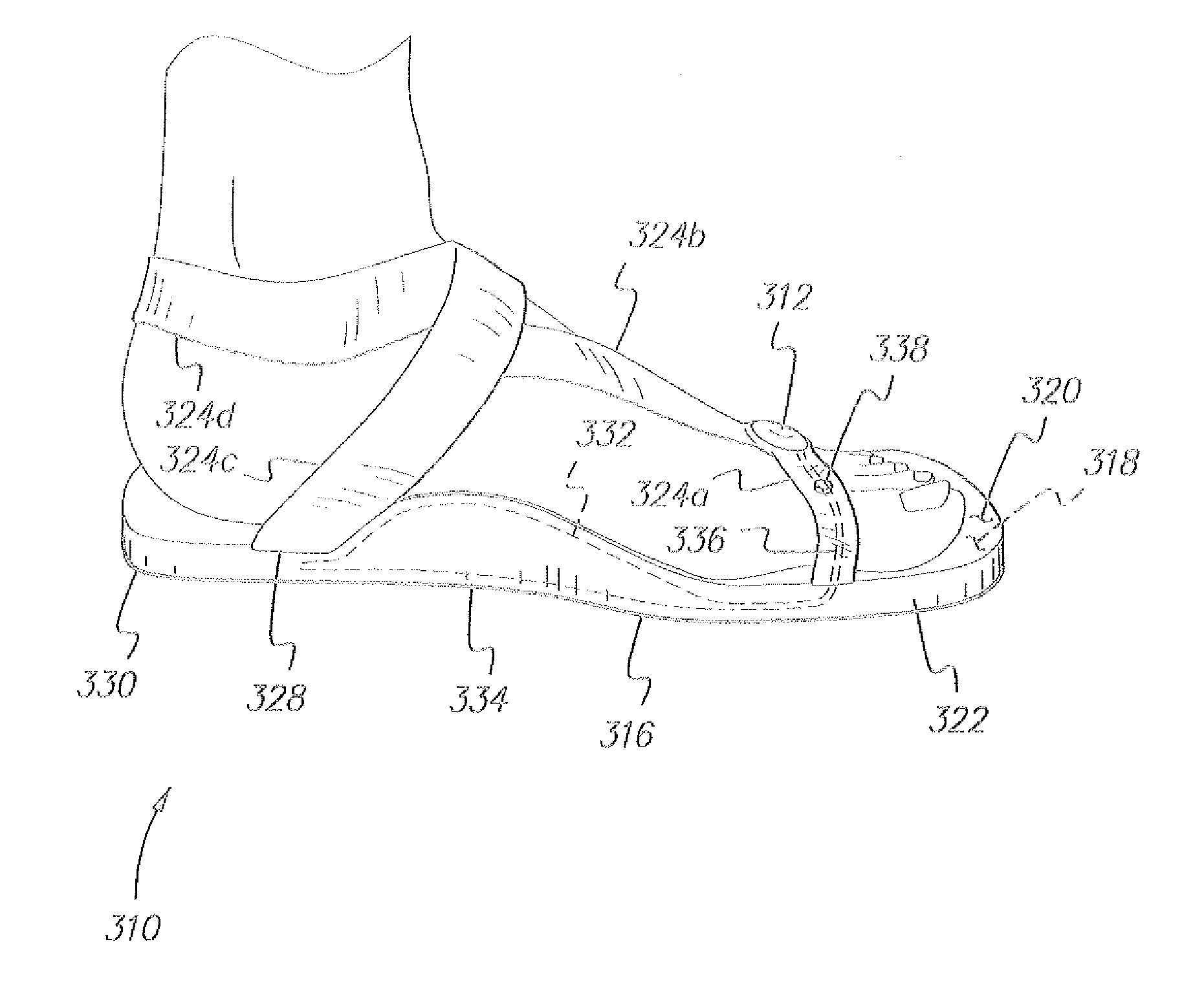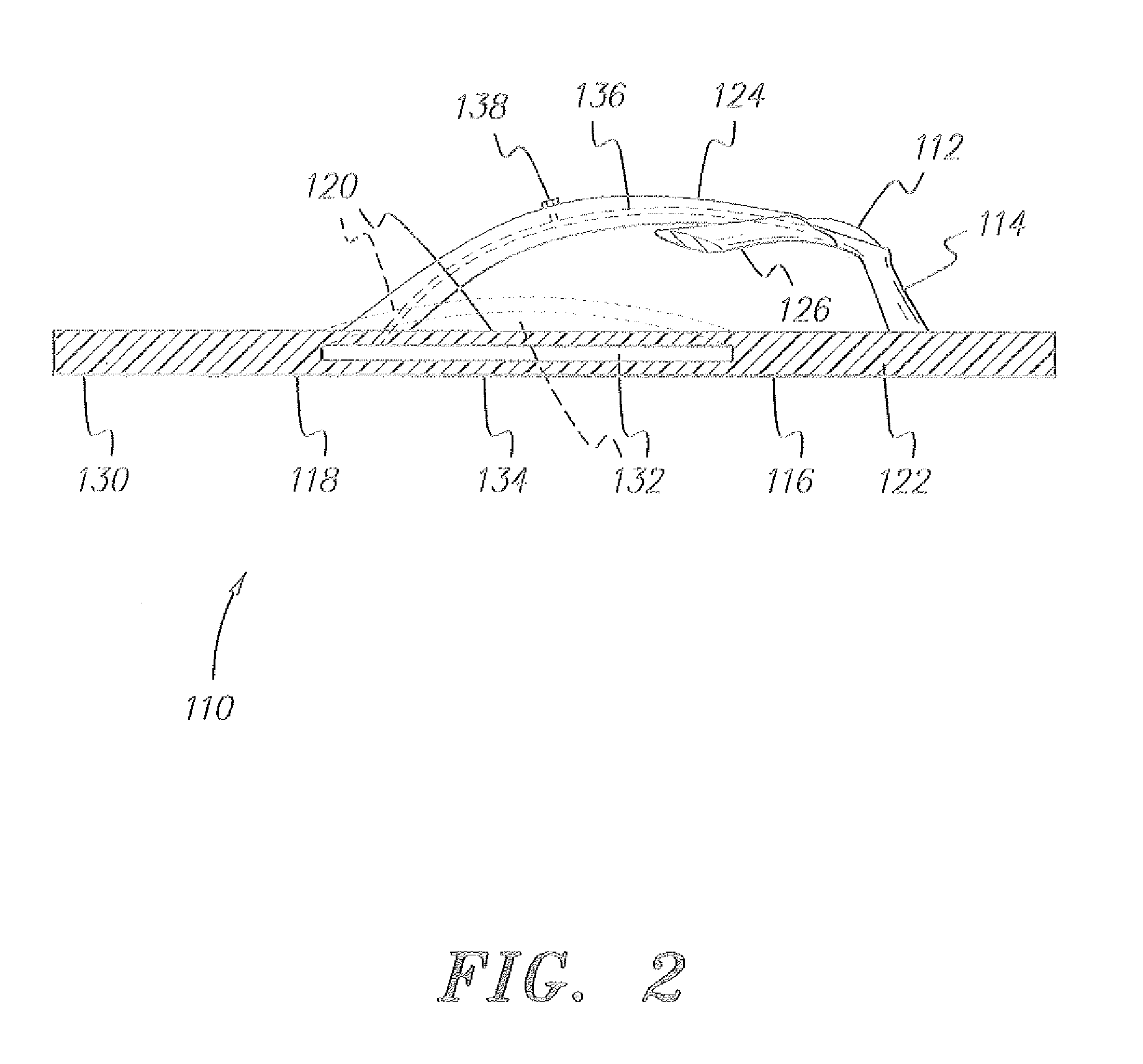Sandal with pneumatic support
a technology of pneumatic support and sandal, which is applied in the field of open shoes or sandals, can solve the problems of strength of the foot, affecting the support ability of the foot,
- Summary
- Abstract
- Description
- Claims
- Application Information
AI Technical Summary
Benefits of technology
Problems solved by technology
Method used
Image
Examples
first embodiment
[0020]FIGS. 1 and 2 of the drawings illustrate a sandal with pneumatic support, designated generally as 110 in the drawings, which is a flip-flop sandal having a small, manually actuated air pump 112 permanently affixed atop the toe divider 114 of the sandal, and integrally formed therewith. The flat sole 116 is devoid of supportive contour for the foot, other than the pneumatic arch support. The sole 116 has a lower surface 118, an upper surface 120 parallel thereto, and a core 122 therebetween, and may be formed of leather, foam or other resilient plastic material, or other suitable material. Opposite first and second foot-securing straps 124 and 126 extend from the top of the toe divider 114 rearward to opposite points along the rearward periphery 128 of the sole 116 near the heel portion 130 thereof.
[0021]The sole 116 includes a pneumatically inflatable bladder 132 disposed within the core 122 between the upper and lower surfaces 118 and 120, in the arch portion 134 of the sole....
second embodiment
[0023]FIGS. 3 and 4 illustrate a zori or flip-flop type sandal, designated as sandal 210. The sandal 210 is quite similar to the sandal 110 of FIGS. 1 and 2, discussed in detail above, but the air pump 212 has been relocated to an area within the heel portion 230 of the sole 216 where it is contained integrally therein as a permanent component. Otherwise, the sandal 210 is much like the sandal 110 of FIGS. 1 and 2. The sole 216 has a lower surface 218, an upper surface 220 parallel thereto, and a core 222 therebetween. The sole 216 is formed of leather, foam or other resilient plastic material, or other suitable material. Opposite first and second foot-securing straps 224 and 226 extend from the top of the toe divider 214 rearward to opposite points along the rearward periphery 228 of the sole 216 near the heel portion 230 thereof.
[0024]The sole 216 includes a pneumatically inflatable bladder 232 disposed within the core 222 between the upper and lower surfaces 218 and 220, in the a...
embodiment 310
[0028]The sole 316 includes a pneumatically inflatable bladder 332 disposed within the core 322 between the upper and lower surfaces 318 and 320, in the arch portion 334 of the sole. The bladder 332 is shown in its distended state in broken lines in FIG. 5, as it would appear when inflated. In the sandal embodiment 310 of FIG. 5 the small, manually actuated air pump 312 used to inflate the bladder 332 is permanently and integrally disposed atop the juncture of the forward lateral strap 324a and the upper strap 324b. The air pump 312 is structured much the same as the air pump 212 illustrated in section in FIG. 4 for the sandal 210. However, it will be seen that the pump 312 may be located elsewhere on the sandal, so long as it communicates pneumatically with the air bladder 332.
[0029]In the example illustrated in FIG. 5, the bladder 332 communicates pneumatically with the air pump 312 by means of an elongate air passage 336, shown in broken lines in FIG. 5, that extends through the ...
PUM
 Login to View More
Login to View More Abstract
Description
Claims
Application Information
 Login to View More
Login to View More - R&D
- Intellectual Property
- Life Sciences
- Materials
- Tech Scout
- Unparalleled Data Quality
- Higher Quality Content
- 60% Fewer Hallucinations
Browse by: Latest US Patents, China's latest patents, Technical Efficacy Thesaurus, Application Domain, Technology Topic, Popular Technical Reports.
© 2025 PatSnap. All rights reserved.Legal|Privacy policy|Modern Slavery Act Transparency Statement|Sitemap|About US| Contact US: help@patsnap.com



